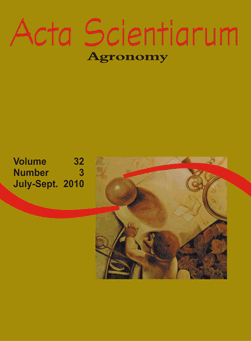<b>Discriminação de unidades de paisagem para fins de levantamentos pedológicos por meio da resposta espectral orbital</b> - doi: 10.4025/actasciagron.v32i3.6144
Resumo
O objetivo deste trabalho foi comparar dois métodos de levantamentos de solos. O primeiro foi realizado por meio de metodologias tradicionalmente utilizadas na distinção das unidades de paisagem e discriminação das classes de solos, como fotointerpretação e relação solo-paisagem. O segundo foi baseado na distinção das classes de solos por meio da sua resposta espectral, obtida em nível orbital. Para o estabelecimento dos atributos dos solos e sua classificação, as amostras de solo foram coletadas em duas profundidades, num grid com pontos distanciados de 500 m. Com essas amostras foram realizadas análises físicas e químicas dos solos. Nos locais de amostragem foi determinada, a partir da imagem orbital, a reflectância aparente do solo e, por meio de análise de agrupamentos, foram estabelecidas as unidades de paisagem. A fidedignidade de semelhança entre as unidades de paisagem obtidas pelos dois métodos foi avaliada pelo índice Kappa, cujo valor foi de 0,43, indicando que ambos os métodos produziram resultados semelhantes na discriminação de classes de solo.Downloads
DECLARAÇÃO DE ORIGINALIDADE E DIREITOS AUTORAIS
Declaro que o presente artigo é original, não tendo sido submetido à publicação em qualquer outro periódico nacional ou internacional, quer seja em parte ou em sua totalidade.
Os direitos autorais pertencem exclusivamente aos autores. Os direitos de licenciamento utilizados pelo periódico é a licença Creative Commons Attribution 4.0 (CC BY 4.0): são permitidos o compartilhamento (cópia e distribuição do material em qualqer meio ou formato) e adaptação (remix, transformação e criação de material a partir do conteúdo assim licenciado para quaisquer fins, inclusive comerciais.
Recomenda-se a leitura desse link para maiores informações sobre o tema: fornecimento de créditos e referências de forma correta, entre outros detalhes cruciais para uso adequado do material licenciado.




















































